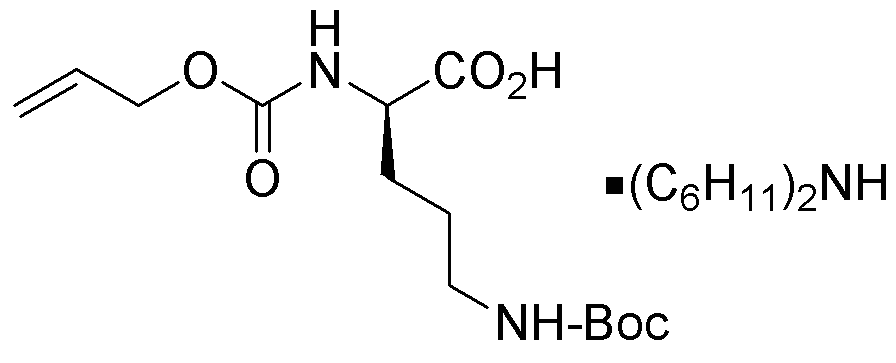Na-Allyloxycarbonyl-Nd-Boc-D-ornithine dicyclohexyl ammonium salt is widely utilized in research focused on
- Peptide Synthesis: This compound serves as a key building block in the synthesis of peptides, particularly in the development of therapeutic agents. Its unique structure allows for the introduction of specific functional groups that enhance peptide stability and activity.
- Drug Development: In pharmaceutical research, it is used to create novel drug candidates. The compound's ability to modify amino acid properties makes it valuable for designing drugs with improved efficacy and reduced side effects.
- Bioconjugation: This chemical is effective in bioconjugation processes, where it helps link biomolecules to drugs or imaging agents. This application is crucial in developing targeted therapies and diagnostic tools in oncology.
- Research in Biochemistry: It is utilized in biochemical studies to explore the interactions between proteins and small molecules. This helps researchers understand biological pathways and develop new therapeutic strategies.
- Material Science: The compound is also applied in the field of material science for creating functionalized polymers. These materials can be engineered for specific applications, such as drug delivery systems or biosensors.
General Information
Properties
Safety and Regulations
Applications
Na-Allyloxycarbonyl-Nd-Boc-D-ornithine dicyclohexyl ammonium salt is widely utilized in research focused on
- Peptide Synthesis: This compound serves as a key building block in the synthesis of peptides, particularly in the development of therapeutic agents. Its unique structure allows for the introduction of specific functional groups that enhance peptide stability and activity.
- Drug Development: In pharmaceutical research, it is used to create novel drug candidates. The compound's ability to modify amino acid properties makes it valuable for designing drugs with improved efficacy and reduced side effects.
- Bioconjugation: This chemical is effective in bioconjugation processes, where it helps link biomolecules to drugs or imaging agents. This application is crucial in developing targeted therapies and diagnostic tools in oncology.
- Research in Biochemistry: It is utilized in biochemical studies to explore the interactions between proteins and small molecules. This helps researchers understand biological pathways and develop new therapeutic strategies.
- Material Science: The compound is also applied in the field of material science for creating functionalized polymers. These materials can be engineered for specific applications, such as drug delivery systems or biosensors.
Documents
Safety Data Sheets (SDS)
The SDS provides comprehensive safety information on handling, storage, and disposal of the product.
Product Specification (PS)
The PS provides a comprehensive breakdown of the product’s properties, including chemical composition, physical state, purity, and storage requirements. It also details acceptable quality ranges and the product's intended applications.
Certificates of Analysis (COA)
Search for Certificates of Analysis (COA) by entering the products Lot Number. Lot and Batch Numbers can be found on a product’s label following the words ‘Lot’ or ‘Batch’.
*Catalog Number
*Lot Number
Certificates Of Origin (COO)
This COO confirms the country where the product was manufactured, and also details the materials and components used in it and whether it is derived from natural, synthetic, or other specific sources. This certificate may be required for customs, trade, and regulatory compliance.
*Catalog Number
*Lot Number
Safety Data Sheets (SDS)
The SDS provides comprehensive safety information on handling, storage, and disposal of the product.
DownloadProduct Specification (PS)
The PS provides a comprehensive breakdown of the product’s properties, including chemical composition, physical state, purity, and storage requirements. It also details acceptable quality ranges and the product's intended applications.
DownloadCertificates of Analysis (COA)
Search for Certificates of Analysis (COA) by entering the products Lot Number. Lot and Batch Numbers can be found on a product’s label following the words ‘Lot’ or ‘Batch’.
*Catalog Number
*Lot Number
Certificates Of Origin (COO)
This COO confirms the country where the product was manufactured, and also details the materials and components used in it and whether it is derived from natural, synthetic, or other specific sources. This certificate may be required for customs, trade, and regulatory compliance.

